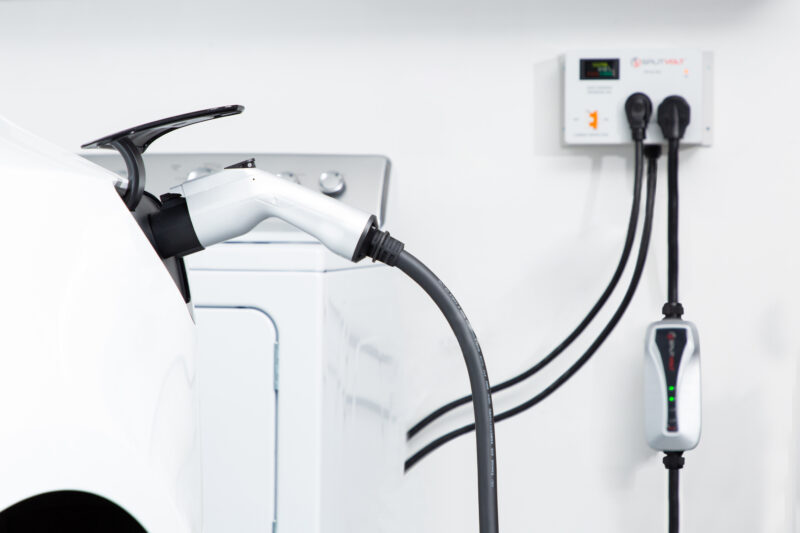EV Home Charging Safety: What’s The NEC 80% Rule For EV Charging & Why Does It Matter?
 First, let’s start with a common sense disclaimer. I am not an electrician, and although the intent of the article is to inform and provide insights into some key considerations regarding EV charging, this is not meant to be comprehensive–and you should consult a certified electrician and applicable building codes when dealing with electrical power in the home or business. With that out of the way, let’s get into it…
First, let’s start with a common sense disclaimer. I am not an electrician, and although the intent of the article is to inform and provide insights into some key considerations regarding EV charging, this is not meant to be comprehensive–and you should consult a certified electrician and applicable building codes when dealing with electrical power in the home or business. With that out of the way, let’s get into it…
The NEC (National Electric Code) defines safety electrical standards for homes. Since EV charging is relatively new, the NEC had to modify its existing safety load standards since EV charging can run continuously (defined as greater than 3 hours) for 3, 6, or even 12 hours straight–a situation that was not anticipated in the original safety code.
The NEC 80% rule stipulates that for EV charging, electrical circuits should not be continuously loaded to more than 80% of their maximum rated capacity. This means that for a standard 240V 30amp household dryer circuit, if you wish to use it for EV charging you must limit your charging rate to 24 amps (80% of 30 amps) otherwise it could stress and overheat your wiring.
Sounds simple, right? Well, it’s only simple if you’re aware of this risk and set your EV charging rate appropriately. Most people are not aware of this, and reasonably (but mistakenly) assume that they may charge at 30amps on an 30amp circuit. However, as mentioned, this is not considered safe according to the NEC, and can lead to wear-and-tear on the circuit components and putting your wiring and home at risk of fire. Even worse, the standard house panel breaker is set for 30 amps and will not trip if you exceed the 24amp charging limit–meaning on its own, the standard house panel breaker is not able to protect your house wiring sufficiently for EV charging.

This article is intended as a primer is to help understand a bit about how this all works, and why/how innovative new solutions like the Splitvolt Splitter Switch can automatically, and safely allow you to share your existing 240V dryer circuit with your EV charger, while ensuring you cannot accidentally exceed the NEC safe-charging levels.
As you will come to understand from this article, probably the single-most important feature providing this protection is having an internal safety circuit breaker within the Splitter Switch itself–and NOT relying on the house panel breaker. Other critical safety elements for such a solution include having a real-time power status display, a flexible plug cord for safe orientation and positioning, as well as having a power-off manual override switch, and cETLus product safety certification.
As a result, it’s the only such plug-and-play solution that you can simply plug in, and within moments have automatic, safe fast home charging for a fraction of the cost of installing a new circuit.
So with this context in mind, let’s take a closer look at how this works and why it matters.
Electrical Circuits
An electrical circuit is a closed loop that provides a path for an electrical current to flow. It typically consists of a power source, such as a home circuit panel, or in other cases to a battery or generator, connected to a light bulb or motor, through conductive wiring. Electrical circuits can be simple or complex, depending on the application and the number of components involved.
A home or business will have a number of circuits, and you can see the different runs of wires in your electrical panel. In many cases, multiple plugs and lights share a single circuit. These are typically standard 110V (Level 1) shared plugs connected throughout your house, with a couple 240V circuits going directly to specific appliances such as electric dryers, electric ranges, water heaters or other appliances.
Electrical circuits have a limited capacity depending upon the thickness (gauge) of the wiring, as well as the rating of the breakers, receptacles and plugs. These levels are all defined within the NEC. Obviously staying within the circuit ratings, and safe charging rates defined by the NEC, and consulting with local electricians familiar with building codes is incredibly important. If you ever have questions about the condition of your electrical systems, or whether your meeting code, consulting an electrician is the safest route.
If you pull less power than the rated limit and continuous charging rate for EV charging, nothing bad will happen and the whole process is safe and simple. But, it is possible to pull too much power, so understanding how this works is important.
What Happens When Circuits Get Overloaded?
Overloading an electrical circuit with too many loads plugged in can cause a variety of problems, ranging from minor inconveniences to serious and deadly hazards.
The most common thing that happens to an overloaded circuit is a tripped circuit breaker. Circuit breakers are an important safety feature in modern electrical systems. They work by automatically cutting off the flow of electricity when the current exceeds the breaker’s rating in an electrical circuit. The key here is that the breaker must be set at the appropriate level (rating) for the particular use. If you use a breaker that is set too high for the wiring, then you would not get the protective benefits that are intended.
Circuit breakers typically consist of three main components: a switch, a trip unit, and a mechanism for operating the switch. When electricity flows through the circuit, it passes through the switch on the circuit breaker. The trip unit monitors the electrical current flowing through the circuit and will trigger the switch to open if it detects an overcurrent, such as an electrical short or an overloaded circuit.
When the switch opens, it interrupts the flow of electricity, cutting off the circuit so that no more electricity can flow. This generally keeps truly bad things from happening, but you do lose power on that circuit.
But, breakers don’t always work like they should (for reasons we’ll get into in a minute) and cannot protect in every scenario–especially if they are not the correct rating. When they fail to cut the flow of power, the overloaded wires can overheat. This can damage the protective coating on the wires, the insulation within the wire, NEMA plugs and receptacles, and maybe even the wire itself. Overloaded wiring can breakdown and cause gaps, or weaken connections to receptacles or plugs, which can lead to arcing and in the worst case, the overheated wires get really, really hot. Hot enough to start a fire, in fact. This happens because the wire’s insulation or plastic coating breaks down, or connections loosen forming gaps which can lead to arcing and high temperatures potentially leading to fire.
Even Lightly Overloaded Circuits Over Extended Periods, Can Damage Their Own Safety Systems
In many cases, people overload an electrical circuit and nothing bad happens, at least not right away. The system is just barely overloaded, and there’s not enough heat to start a fire or anything immediate. So, the amateur electrician or extension cord guru assumes everything is fine.
But, even if you don’t have an electrical fire or a tripped breaker right away, that doesn’t mean danger isn’t lurking. Why? Because mildly overloaded circuits damage the electrical components, including circuit breakers. Over time, an overloaded circuit breaker, wiring, receptacles, or plugs can get worn out to the point where their safety features stop working properly.
The NEC 80% Rule Gives A Margin Of Safety
The 80% rule exists to ensure that circuits operate within a safe range for all of the components in the circuit. For EV charging, this rule is especially important given the time spent charging and the power levels involved.
The math for the 80% rule is pretty simple. For example, if a circuit is rated for a maximum of 30 amps, it shouldn’t carry more than 24 amps (80% of its capacity) to charge an EV. This rule also applies to other amperage levels such as safe charging at 40 amps on a 50 amp rated circuit. Following your local electrical code guidelines, the NEC guidelines, and to the NEC 80% rule helps maintain the safety, stability, and longevity of electrical circuits and equipment.
Saving Money Doesn’t Have To Mean Rolling The Dice On Safety
One of the things that’s challenging about owning an EV is charging it at home. If your home doesn’t already have a 240-volt Level 2 EV charging circuit, installing one can cost hundreds or thousands of dollars, and take weeks to schedule, depending on what all needs to be done.
Fortunately, there’s another option: Using existing 240-volt wiring your house probably already has to power its dryer. In many cases, it’s even in or near your garage! Hooking up an EV charger to share a circuit with your dryer does come with the risk of violating the 80% rule, though. If your dryer’s circuit is only rated for 30 amps and your car pulls the full 30 amps, you’re not within this important safety guideline. If you’re limiting the charge with your car’s settings, those settings can be lost or changed by a family member who doesn’t know better, risking problems.
Fortunately, there’s a solution. Splitvolt invented a new category of product called the Splitvolt Splitter Switch to make it automatic, safer, simpler and less expensive to get 240V Level 2 home charging. It not only automatically and safely switches power between your car and dryer, but its internal breaker is set to the maximum NEC safe charging limit so it will trip if you were to accidentally charge at too high of a rate and is safer than relying on a panel breaker which is set higher and above the NEC safe threshold. If the car’s settings get changed to pull too much power, the Splitvolt stops the power flow to keep things safe.

Splitvolt’s Safety Features
Splitvolt offers an array of safety features that include automatic power switching and an internal safety circuit breaker to prevent overcharging, cETLus safety certification, real time power status display, a manual override power-off switch and a flexible pigtail power cord for safe orientation and easier accessibility.
These features make Splitvolt the ideal, and only such solution for homeowners looking to utilize their existing 240V Level 2 dryer circuit for EV charging by automatically and safely sharing their existing circuit without the expense, permit complexity or time of having an electrician install a new circuit. They’ve got the only such solution on the market with all of these essential safety features.
You can learn more about Splitvolt’s products here
This article is supported by Splitvolt.
Have a tip for CleanTechnica? Want to advertise? Want to suggest a guest for our CleanTech Talk podcast? Contact us here.
Latest CleanTechnica.TV Videos

CleanTechnica uses affiliate links. See our policy here.


